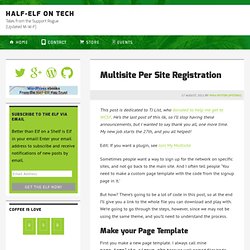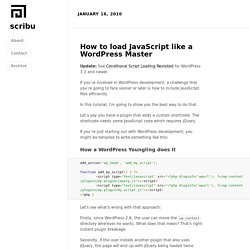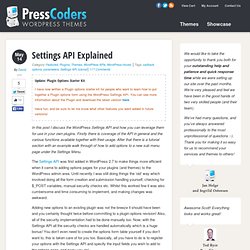

MailPoet Newsletters (formerly Wysija) Create newsletters, post notifications and autoresponders.

Drop your posts, images, social icons in your newsletter. Change fonts and colors on the fly. Manage all your subscribers. A new and simple newsletter solution for WordPress. Finally! Multisite Per Site Registration. This post is dedicated to TJ List, who donated to help me get to WCSF.

He’s the last post of this ilk, so I’ll stop having these announcements, but I wanted to say thank you all, one more time. My new job starts the 27th, and you all helped! Easy Tynt. ClickDesk Live Support - Live Chat - Help Desk Plugin for Websites. WordPress Backup to Dropbox. WordPress Backup to Dropbox has been created to give you peace of mind that your blog is backed up on a regular basis.

Just choose a day, time and how often you wish yor backup to be performed and kick back and wait for your websites files and a SQL dump of its database to be dropped in your Dropbox! You can set where you want your backup stored within Dropbox and on your server as well as choose what files or directories, if any, you wish to exclude from the backup. The plugin uses OAuth so your Dropbox account details are not stored for the plugin to gain access. Checkout the website - Setup Once installed, the authorization process is easy - Auto Multisite Registration. There are plugins for this, and I’m rather fond of them.

If you just want all new users to be added to some (or all) sites, then I suggest you use Multisite User Management. It’s a great plugin, and lets you pick and chose.
How to load JavaScript like a WordPress Master. Update: See Conditional Script Loading Revisited for WordPress 3.3 and newer.

If you’re involved in WordPress development, a challenge that you’re going to face sooner or later is how to include JavaScript files efficiently. In this tutorial, I’m going to show you the best way to do that. Let’s say you have a plugin that adds a custom shortcode. The shortcode needs some JavaScript code which requires jQuery. So you want to create WordPress themes huh?
How to Create Tabs in WordPress Settings Pages. Advertisement Using tabs in a user interface can help you better organize content, so it’s only natural that WordPress themes that have a lot of options would benefit from tabs on their settings page.

In this tutorial, you will learn how to create a tabbed settings page, and you’ll get to download a WordPress theme that implements the code. Overview To get a quick grasp of the tabs we’ll be creating, go to Appearance/Themes in the WordPress admin area. You will find two tabs there: “Manage Themes” and “Install Themes.” The process is actually fairly simple: we set and send a tab variable when a tab is clicked. In our approach, there are three times when we will need to know which tab the user is currently on: For the sake of brevity, we won’t explain all of the code, only the snippets that are relevant to this approach. Creating The Tabs. How To Create a WordPress Theme: The Ultimate WordPress Theme Tutorial. Update: We’ve created a second edition of this popular tutorial!

It contains updated code samples, coverage of the latest theme development techniques, and more.
BulletProof Security. Htaccess Core Website Security (Security/Firewalls) WordPress Website Security Protection: BulletProof Security protects your WordPress website against XSS, RFI, CRLF, CSRF, Base64, Code Injection and SQL Injection... hacking attempts.

One-click .htaccess WordPress security protection. Protects wp-config.php, bb-config.php, php.ini, php5.ini, install.php and readme.html with .htaccess security protection. Security Logging. HTTP Error Logging. Login Security & Monitoring Website Security (Security/Monitoring) Akismet. Akismet checks your comments against the Akismet web service to see if they look like spam or not and lets you review the spam it catches under your blog's "Comments" admin screen.

Major new features in Akismet 2.5 include: A comment status history, so you can easily see which comments were caught or cleared by Akismet, and which were spammed or unspammed by a moderatorLinks are highlighted in the comment body, to reveal hidden or misleading linksIf your web host is unable to reach Akismet's servers, the plugin will automatically retry when your connection is back upModerators can see the number of approved comments for each userSpam and Unspam reports now include more information, to help improve accuracy.
Woocommerce on order complete insert quantity data into custom database table. Wordpress Plugin Development. Settings API Explained. Update: Plugin Options Starter Kit I have now written a Plugin options starter kit for people who want to learn how to put together a Plugin options form using the WordPress Settings API.

You can see more information about the Plugin and download the latest version here. Have fun, and be sure to let me know what other features you want added in future versions! In this post I discuss the WordPress Settings API and how you can leverage them for use in your own plugins. Firstly there is coverage of the API in general and the various functions available together with their usage. Building your first WordPress plugin (part 3) There is no need to ask why anybody would want to write a plugin for WordPress. It’s one of the primary features that makes WordPress so flexible and a good fit for a wide range of projects. In the first part of our series we created the base for a WordPress plugin recognisible by the core. Then, in the second part we learnt how to alter the default functionality of the core.
Today we’re going to look at plugin options. This is one of the most common tasks that plugins need to perform. Building your first WordPress plugin (part 2) In the previous part of our series we created the base for a WordPress plugin recognisible by the core. Today we are going to learn how to actually alter the default functionality of the core.
The concept of hooks, actions, and filters is responsible for that; being the real heart of the whole WordPress plugins system. Everything starts from the “hooks” provided by the core itself. What is a “hook”? It is a specially marked place in the code (of any script), where some deliberately registered – “hooked into” – functions can be executed in the order defined upon registration. WordPress has two types of hooks that differ in their purpose: Action hook: marks the place to perform an action, for example, process input and store results in a databaseFilter hook: marks the place to apply a modification to a value (normally provided as variable), so that the following code will use the adjusted value Let’s dive into the details… Working with actions.
Building your first WordPress plugin (part 1) One of the primary reasons for WordPress’ continued popularity is the ease with which it can be extended and customized with plugins. Building a plugin may seem like an impossible task, but it’s simpler than you may think. Today we begin our “Building your first WordPress plugin” series that will cover the most important principles and how-tos of the process. By the end of the series you’ll be fully prepared to make further experiments of your own, relying on best practices and conventions adopted by the extensive WordPress community.
Customizing Your WordPress Admin. The backend of WordPress is one of the better ones out there. However, depending on your needs, the menu can be a little crowded with fluff that you just don't want or need there. In this tutorial, I am going to show you how to tame your admin menu. I will show you how to rename menus, reorder the menus, or just plain eliminate them without touching core. Enable HTTP Keep-Alive in WordPress.
MyCRED Hooks 101. Description In this tutorial, I will show you how to award users for completing their profile using our very own custom hook. The code snippets presented here should be placed in your theme’s functions.php file or in your plugin. Requirements myCRED installed and setupBasic understanding of the PHP language! Awarding points for users who “Share” a post. Mycred_video. Description. Tutorials. Mycred_my_rank. Description This shortcode allows you to show a given users rank with the option to show just the rank name and or logo. If no user id is given and the current user is not logged in, this shortcode will return NULL. Requires the Ranks Add-on. Usage. Mycred_my_balance. Description This shortcode returns the current users myCRED points balance. Mycred_history.